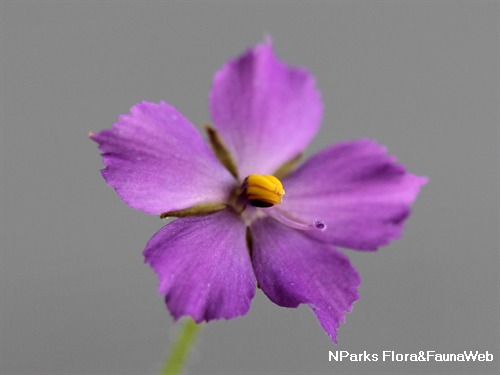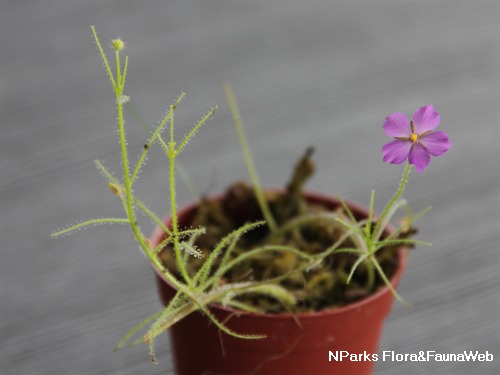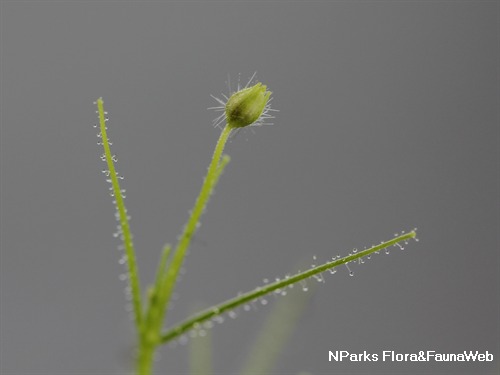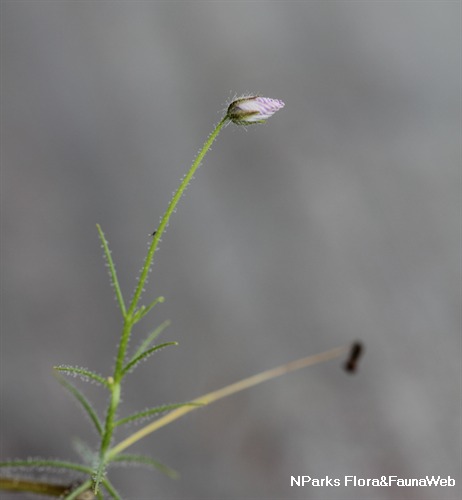
Name
Classifications and Characteristics
| Plant Growth Form | Herbaceous Plant |
|---|---|
| Lifespan (in Singapore) | Annual |
| Mode of Nutrition | Heterotrophic |
| Plant Shape | Weeping / Pendulous, Fountain (Palm-like) |
| Maximum Height | 30 cm |
Biogeography
| Native Distribution | Australia |
|---|---|
| Native Habitat | Terrestrial (Desert / Semi-Desert) |
| Preferred Climate Zone | Sub-Tropical / Monsoonal |
| Local Conservation Status | Non-native |
Description and Ethnobotany
| Growth Form | Carnivorous annual herb up to 30 cm tall. It is initially erect, and then becomes trailing. |
|---|---|
| Foliage | This species has narrow, linear leaves which look like branches off the stem. They are triangular in cross-section and covered in tentacles with sticky, clear dew. Insects get stuck on the dew and eventually die of suffocation or exhaustion. Short, stalkless tentacles produce enzymes to digest the insect bodies. |
| Stems | The thin, round stem is covered in dewy tentacles. |
| Flowers | The purple or white, star-shaped flowers (about 2 cm wide) are generally solitary and occur in the leaf axils. |
| Similar | This species looks similar to species in the genus Drosera, but it has completely clear tentacles while Drosera spp. tentacles have dew dotted with red in the centre. Byblis tentacles and leaves are stationery, whereas those of Drosera bend and parts of the leaf roll to help secure the struggling prey |
| Cultivation | This species tends to eventually die back and can be propagated by stem cuttings. It grows best outdoors where it can receive bright light. |
| Etymology | The genus Byblis is named after a nymph in Greek mythology who died of unrequited love and became a fountain. Members of the Byblis genus resemble fountains because of their form and the dew produced by their tentacles. |
Landscaping Features
| Desirable Plant Features | Ornamental Flowers, Ornamental Foliage |
|---|---|
| Landscape Uses | Container Planting, Suitable for Hanging Baskets |
Plant Care and Propagation
| Light Preference | Full Sun |
|---|---|
| Water Preference | Lots of Water |
| Rootzone Tolerance | Well-Drained Soils, Acidic (low pH) Soils |
| Maintenance Requirements | Moderate |
| Pest(s) | Sucking Insects |
| Propagation Method | Stem Cutting |
Foliar
| Foliage Retention | Evergreen |
|---|---|
| Mature Foliage Colour(s) | Green - Light Green |
| Foliar Modification | Trichome / Hair |
| Foliar Type | Simple / Unifoliate |
| Foliar Arrangement Along Stem | Spiral |
| Foliar Attachment to Stem | Sessile |
| Foliar Shape(s) | Non-Palm Foliage (Acicular / Needle) |
| Foliar Apex - Tip | Acuminate |
| Foliar Base | Truncate / Square |
| Typical Foliar Size | 3 cm to 4 cm |
Floral (Angiosperm)
| Flower Colour(s) | Purple, White |
|---|---|
| Flower Texture(s) | Wrinkled |
| Flower Grouping | Solitary |
| Flower Location | Axillary |
| Flower Symmetry | Radial |
| Individual Flower Shape | Stellate / Star-shaped |
| Flower Size | 2 cm |
Image Repository
Others
| Master ID | 32772 |
|---|---|
| Species ID | 7184 |
| Flora Disclaimer | The information in this website has been compiled from reliable sources, such as reference works on medicinal plants. It is not a substitute for medical advice or treatment and NParks does not purport to provide any medical advice. Readers should always consult his/her physician before using or consuming a plant for medicinal purposes. |



